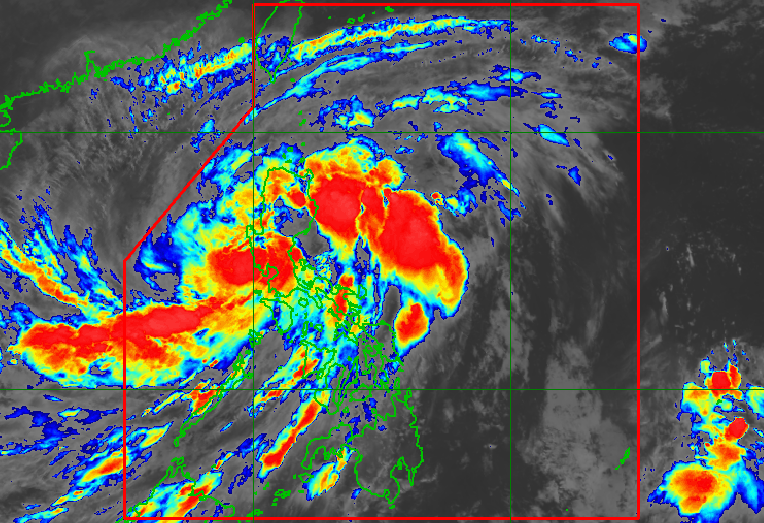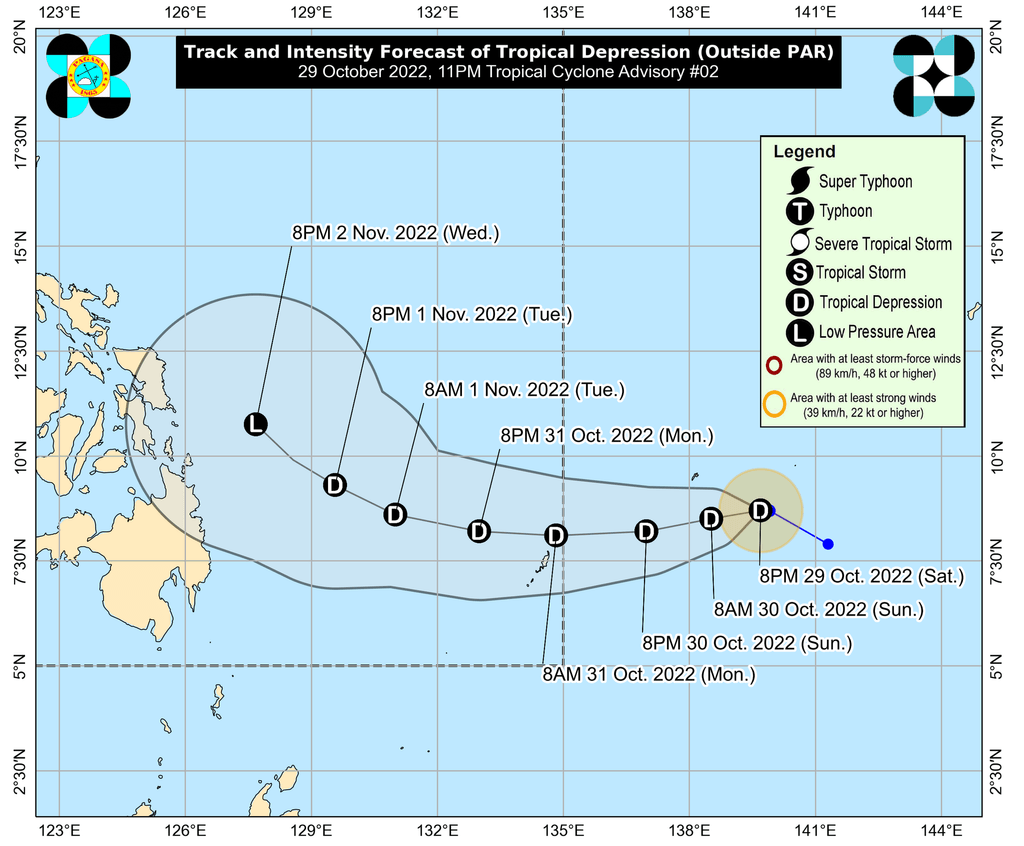SUMMARY
This is AI generated summarization, which may have errors. For context, always refer to the full article.

MANILA, Philippines – Severe Tropical Storm Paeng (Nalgae) shifted north northwest late Saturday evening, October 29, passing over Laguna de Bay and the Metro Manila-Rizal-Bulacan area after Cavite.
In a bulletin released past 11 pm on Saturday, the Philippine Atmospheric, Geophysical, and Astronomical Services Administration (PAGASA) said Paeng was already in the vicinity of Baliuag, Bulacan, moving north northwest at a slightly slower 15 kilometers per hour from the previous 20 km/h.
PAGASA said Paeng is now likely to exit the landmass of Luzon within 6 to 12 hours, or by Sunday morning, October 30, then leave the Philippine Area of Responsibility (PAR) on Monday, October 31.
At the moment, the severe tropical storm still has maximum sustained winds of 95 km/h and gustiness of up to 160 km/h.
PAGASA said Paeng could maintain its strength as it continues to cross land, but there is a chance it may slightly weaken in the next 6 hours. It is likely to re-intensify, however, once it is already over the West Philippine Sea.
Paeng made landfall five times, all on Saturday:
- Virac, Catanduanes – 1:10 am
- Caramoan, Camarines Sur – 1:40 am
- Buenavista, Quezon – 6 am
- Santa Cruz, Marinduque – 8:40 am
- Sariaya, Quezon – 1:40 pm
After hitting Quezon for a second time, Paeng crossed Laguna, Cavite, then the Metro Manila-Rizal-Bulacan area.
PAGASA Weather Specialist Benison Estareja said in a briefing that from Baliuag, Paeng is projected to cross other parts of Bulacan, Pampanga, and the Zambales-Bataan area, before emerging over the West Philippine Sea.
Even before its landfalls in Luzon, Paeng already wreaked havoc in parts of Mindanao and the Visayas.
PAGASA updated its rainfall forecast for Sunday, the last day that rain from Paeng will hit the country. Affected areas must stay on alert for floods and landslides even as the severe tropical storm prepares to exit landmass.
Until Sunday morning
Heavy to intense rain, with at times torrential rain
- Metro Manila
- Zambales
- Bataan
- Tarlac
- Pampanga
- Bulacan
- Rizal
- Laguna
- Cavite
- Batangas
- northern part of mainland Quezon
Moderate to heavy rain, with at times intense rain
- mainland Cagayan Valley
- Cordillera Administrative Region
- rest of Central Luzon
- Occidental Mindoro
- Oriental Mindoro
- central part of Quezon including Polillo Islands
Light to moderate rain, with at times heavy rain
- Ilocos Region
- Bicol
- rest of Mimaropa
- rest of Quezon
- Western Visayas
Rest of Sunday
Moderate to heavy rain, with at times intense rain
- Metro Manila
- mainland Cagayan Valley
- Cordillera Administrative Region
- Central Luzon
- Rizal
- Laguna
- Cavite
- Batangas
- northern part of mainland Quezon
- Occidental Mindoro
- Oriental Mindoro
Light to moderate rain, with at times heavy rain
- Ilocos Region
- Bicol
- rest of Mimaropa
- rest of Quezon including Polillo Islands
- Western Visayas
In terms of winds, there are fewer areas under tropical cyclone wind signals as of 11 pm on Saturday.
Signal No. 3
Storm-force winds (89 to 117 km/h), moderate to significant threat to life and property
- northern part of Metro Manila (City of Manila, Valenzuela City, Malabon City, Navotas City, Caloocan City, Quezon City)
- Bataan
- southern part of Zambales (San Marcelino, Subic, Olongapo City, Castillejos, San Antonio, San Narciso, San Felipe, Cabangan, Botolan, Palauig, Iba)
- Pampanga
- Bulacan
- southern part of Tarlac (Concepcion, Capas, San Jose, Bamban)
Signal No. 2
Gale-force winds (62 to 88 km/h), minor to moderate threat to life and property
- Pangasinan
- southern part of Aurora (San Luis, Baler, Dingalan, Maria Aurora)
- rest of Tarlac
- Nueva Ecija
- rest of Zambales
- Laguna
- Batangas
- northern and central parts of Quezon (Alabat, Perez, Plaridel, Atimonan, Unisan, Agdangan, Padre Burgos, Pagbilao, Sariaya, Lucena City, San Antonio, Tiaong, Candelaria, Dolores, Tayabas City, Lucban, Sampaloc, Mauban, General Nakar, Infanta, Real) including Polillo Islands
- Rizal
- Cavite
- rest of Metro Manila
- Cavite
- northern part of Oriental Mindoro (Victoria, Naujan, San Teodoro, Baco, Puerto Galera, Calapan City)
- northern part of Occidental Mindoro (Santa Cruz, Abra de Ilog, Mamburao, Paluan) including Lubang Islands
Signal No. 1
Strong winds (39 to 61 km/h), minimal to minor threat to life and property
- La Union
- Kalinga
- Abra
- Benguet
- Ifugao
- Mountain Province
- Ilocos Sur
- Nueva Vizcaya
- Quirino
- Isabela
- rest of Aurora
- rest of Quezon
- Catanduanes
- Camarines Sur
- Camarines Norte
- Albay
- Sorsogon
- western part of Masbate (Milagros, Mobo, Uson, Masbate City, Aroroy, Balud, Mandaon, Baleno) including Burias Island and Ticao Island
- rest of Occidental Mindoro
- rest of Oriental Mindoro
- Palawan (El Nido, Taytay) including Calamian Islands and Cuyo Islands
- Romblon
- Marinduque
- Capiz
- Aklan
- northern part of Antique (Barbaza, Culasi, Tibiao, Sebaste, Libertad, Bugasong, Laua-an, Pandan) including Caluya Islands
PAGASA added that Paeng’s outer circulation and the surge of the northeast monsoon or hanging amihan will also bring gusty conditions to the rest of Luzon and Western Visayas, especially in coastal and mountainous areas.

There is still a minimal to moderate risk of storm surges up to 2 meters high, which may cause floods in the “low-lying and exposed coastal areas” of the following:
- Bataan (facing Manila Bay)
- Pampanga
- Bulacan
- Metro Manila
- Cavite
- northern part of mainland Quezon
Meanwhile, the gale warning issued at 5 pm on Saturday remains in effect.
- seaboards of Central Luzon and Southern Luzon and western seaboard of Northern Luzon (Aurora, Zambales, Bataan, Pampanga, Bulacan, Metro Manila, Cavite, Batangas, Quezon including Polillo Islands, Occidental Mindoro including Lubang Islands, Oriental Mindoro, Marinduque, Romblon, Camarines Norte, Camarines Sur, Catanduanes, Albay, Sorsogon, Masbate including Burias and Ticao Islands, Ilocos Norte, Ilocos Sur, La Union, Pangasinan) – very rough to high seas, waves 4.5 to 8 meters high
- northern and eastern seaboards of Northern Luzon (Batanes, Cagayan including Babuyan Islands, Isabela) – very rough seas, waves 4.5 to 6 meters high
- seaboards of Visayas and Palawan (Aklan, Antique, Capiz, Iloilo, Guimaras, Negros Occidental, Negros Oriental, Cebu, Bohol, Siquijor, Northern Samar, Samar, Eastern Samar, Biliran, Palawan including Calamian, Cuyo, Cagayancillo, and Kalayaan Islands) – rough to very rough seas, waves 4 to 5.5 meters high
- eastern seaboards of Visayas and Mindanao (Leyte, Southern Leyte, Surigao del Norte including Siargao and Bucas Grande Islands, Dinagat Islands, Surigao del Sur, eastern coast of Davao Oriental) – rough to very rough seas, waves 2.8 to 4.5 meters high
“Rough to high sea conditions are risky for all types of sea vessels. Mariners are advised to remain in port or take shelter in port until winds and waves subside,” PAGASA said.
Paeng is the Philippines’ 16th tropical cyclone for 2022 and the fourth for October.
Aside from Paeng, the weather bureau is monitoring a tropical depression outside PAR.
The tropical depression was located 1,440 kilometers east of northeastern Mindanao on Saturday evening, almost stationary or barely moving.
It still has maximum sustained winds of 45 km/h and gustiness of up to 55 km/h.
PAGASA said the tropical depression may enter PAR on Monday and would be given the local name Queenie.
It is projected to remain a tropical depression until Tuesday, November 1, and may weaken into a remnant low on Wednesday, November 2. This means it is unlikely to directly affect the country.

– Rappler.com
Add a comment
How does this make you feel?





There are no comments yet. Add your comment to start the conversation.